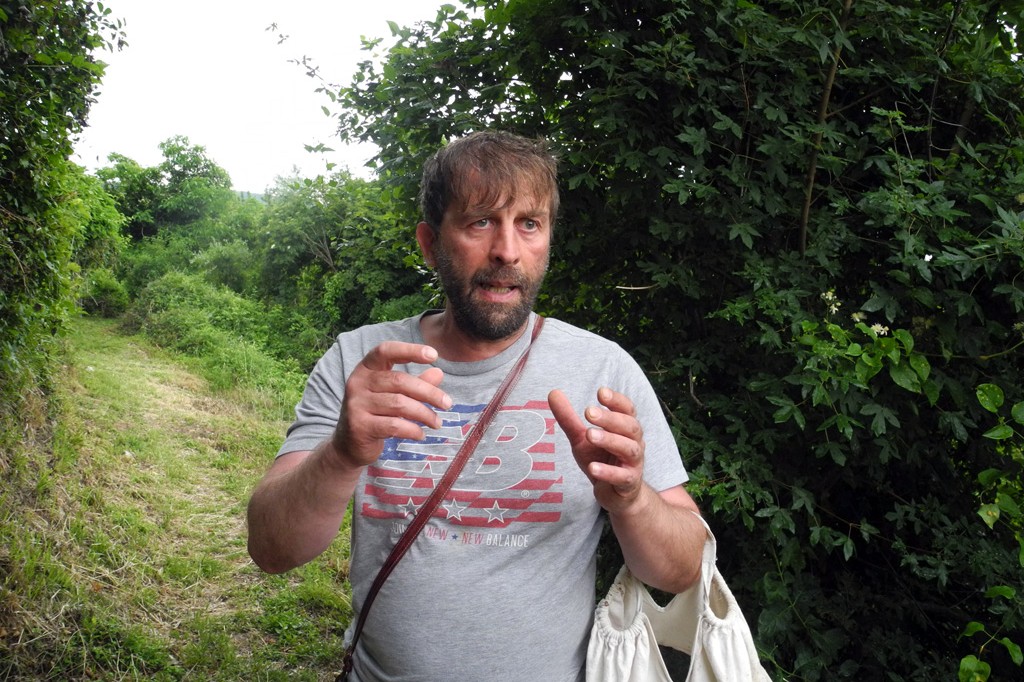Story and photos by Sally Hess Deck
Twinkling green eyes betray the serious look on his face as Davide Cerretini launches into the story of his bees and how he became a beekeeper.
In 1928, at age 18, his grandfather climbed Monte Nerone in the mountain range east of Cagli. Together with two other men, he discovered a swarm of bees in the ground. They used a burlap bag and took the swarm down the mountain to where Davide still lives in Cerreto, a small village tucked in the hills of le Marche between Cagli and Monte Nerone. Davide pauses in his storytelling to emphasize they were lucky the queen did not die during her capture.
As the years went by, Davide’s father and uncle took over the beekeeping from their father. Now Davide alone is the keeper of his family’s tradition. Davide traces his whole life through the bees, having been, he says, “born between the bee hives.”
Davide now keeps 84 hives. When community members see bees swarming, they call on Davide to find them a good home. The community cares deeply for the bees as pollinators for their crops, and they benefit from Davide’s knowledge and skills. Some people are more curious about the swarms than is safe, he explains with a chuckle. He is cautious about the bees and wants to ensure no person or bee is harmed when he relocates a swarm.
Every day he tends to his bees, even the ones faraway. The bees mostly stay in alfalfa fields, but many also forage among the heavily scented tiglio or lime trees. The nearby forest also has chestnut trees and pine trees where the bees search for pollen. The honey from the chestnut trees is highly sought after from community members who buy honey from Davide. It is dark, thick, and rich in healthful minerals. The dark honey is “so good, it shakes the heavens,” Davide says.
Davide is proud of the clean and bright room he uses for his honey harvest. He has a honey extractor that can hold three frames at once as it mechanically spins the honey from the frames while leaving the wax intact for the bees to reuse the next year. He shows off his tools with pride, including the leaf blower that he uses to blow the bees off the hive boxes when it is time for him to harvest the honey.
In early June, the hives are just beginning to fill with honey. In years past, they would be well on their way to a heavy fall harvest, but this is a year of change for Davide and the bees. Although he has a legacy with the bees, in some ways he is starting from scratch—this year he is transitioning from conventional to organic beekeeping. Davide spends his days studying and researching, often taking classes and visiting with a mentor to learn more about the bees.
While studying his bees and the current research on beekeeping, he decided to transition entirely to untreated, chemical-free, organic beekeeping. While he cannot control where the bees fly, he can limit their access to pesticides and other toxins by placing his hives only in the fields he trusts. He does not administer chemical treatments to his hives nor allow them any contact with known toxins. The hive boxes are built of untreated wood, painted in bright colors with organic paints.
When Davide checks on a hive, he approaches from the back, opposite the galvanized metal comb the bees enter through. Davide wears a veil anchored to his shoulders to protect his face and neck, but he leaves his arms and hands unprotected and free to inspect the box. The hum of the bees from the box is electrifying. The bees do not like the rain storm that is passing through, and the box is filled with agitated bees. The bees have been hard at work, and amber beads of propolis along the edges of the box show their attempts at creating a protective seal around their honey stores.
For Davide and his community, the propolis is as highly sought after as the honey. Propolis is similar to resin and is collected by the bees from tree sap and tree buds. It comes in a wide range of colors and is gummy or sticky at room temperature. Davide believes the propolis has medicinal properties and eats some every day to help with headaches. He explains the bees use it to protect the hive from fungus and bacteria.
In addition to the propolis and the honey, Davide also collects and sells bee pollen and royal jelly. Bee pollen is a mixture of honey and the pollen that bees have brought back to the hive. Royal jelly is the substance fed to larvae as they develop and to the adult queen throughout her life. Davide jokes about someday selling bee stings, claiming they can cure arthritis. Was he telling a tall tale, or does Madonna, the pop singer, really use honey bee venom to firm up the skin on her face?
Davide says he works with the bees because it is his passion. With urgency in his voice, he asks, “Should I do something else? This is what I love!” A rooster crows in the distance, and the vista is expansive beyond the plum orchard that shelters the bee boxes. The trees are heavy with green fruit and the promise of a future harvest, just like the bee boxes below.









Comments